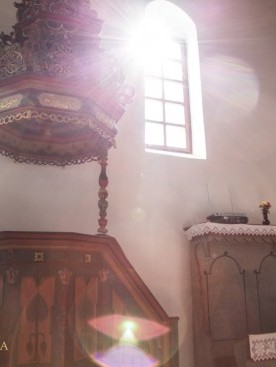Calvinist church in KisszekeresThe first written mention of Kisszekeres dates back to 1181. We have no knowledge when and why the Árpád era church of the village, which is only known from writings, was destroyed. Its foundation walls were only explored in 1986. The first church is placed by the researchers at the turn of the 12th and 13th century. The new church, which can be seen still today, was built on the same site in the late 1400s. The alteration of the church’s interior began with the conversion of the village to Reformed religion, which was implemented in the spirit of the renewal of the religious life of the Reformation. The Gothic vault was replaced by a flat wooden ceiling, the buttresses were demolished similarly to the triumphal arch dividing the nave and the sanctuary, some of the window openings were bricked up, and in order to cover the wall paintings, the walls were lime washed. As part of the restoration process, the starting points at the the footings of the triumphal arch have been reconstructed, and the closing of the arch has been displayed by the soft arch of the lamps hanging down from the ceiling. The hierarchy of space levels has been restored: the level difference between the sanctuary and the nave. Instead of the destroyed wooden ceiling closing the nave in the past, a new, present structured wooden ceiling has been created. Today, the volume of the church, its facades and the system of its openings all represent the original medieval face of the building. As an indication, the demolished vestry has also been reconstructed. The Reformation brought conversion to religious life, the liturgy and the church, also in Kisszekeres In the eastern regions of Szabolcs-Szatmár-Bereg county, most of the churches originally built and used by the Catholics are in the hands of the Reformed. This fact has historical reasons: in this region, the growth of the Reformation was very quick and widespread, and it was evident for the followers of the new religion to enter into possession of the churches used by their ancestors. The Reformation opposed the excessive use of the liturgical elements of Catholicism, and instead, the service was placed in the center of congregational life with a focus on native language evangelization. Accordingly, the pulpits became the most relevant and the most ornamental furnishings of the churches. They were positioned in the places of the medieval pulpits (Csenger), in the centers of the churches to the triumphal arches so that the pastor could be seen and heard from everywhere. The “crown” of the pulpit erected in Kisszekeres on July 12, 1771 is perhaps the most beautiful creation of the master joiner Gábor Vasvári Ódor, who also worked in other churches in the surroundings, for instance, in Mánd and Nagyszekeres. The rich coloring of the “crowns” of the pulpits is reflected on other creations of the Reformation era, on the Chairs of Moses and the breast-shields of the galleries and the pews. The Calvinist congregations had strengthened by the end of the 18th century, so there were painted furniture in every churches across the Upper-Tisza region, eg: the table of the lord, the pulpit, and generally the wooden ceiling, the gallery, the clerical chairs and the benches. Their producers today are called painter-joiners, they were actually carpenters, who could decorate their works with painting. Gábor Ódor Vasvári was the most employed joiner-painter of the region. With reference to the furnishings of the Reformed churches, the sedilia, the pews and the galleries are also worth mentioning. In Medieval times, sitting in the pews during the services was not a general practice, instead, the believers attended the services standing. The celebrants and the bishops had their places in the sanctuary, frequently, in the sedilia built into the southern wall. Since the formation of the monk communities, stalls were erected in the sanctuary. Due to the fact that the secular powers also received places to sit in the churches in the feudal era, maecenases, patrons and developers also built pews and seats. In case of the Hungarian Reformed, following the spread of the Reformation, the Chair of Canon became the Chair of Moses, which served as a seat for the pastor. Nobles, office-holders, leaders of the village, masters, and in general, people with not peasant occupations, and of course the presbytery were the subjects of particular attention. The use of the seats became general in the 17th century. They could be inherited, and they were even involved in last wills. Some of the believers sold their seats without the knowledge of the Church. Between 1711 and 1781, the Church had to launch several investigations in many locations into the determination of the use of the seats, as these matters led to lawsuits in many cases among the believers. Independently from denominations, the most significant principle in the seating order was the separation on the basis of sex: men on the right side, women on the left side. In addition to the strict separation of sexes, the practice of sitting or standing according to generations became common. The changes occurring in marital status or age accompanied with the right for the accordingly adequate seating. The girls had the opportunity to stand in the first row, as it was the position for those available to marry. The boys and the newly-wed men stood on the gallery. The young men generally came down from the gallery in the case of the death of their fathers, as they could occupy their places. The married men stood at the door of the church beneath the choir or outside the church. The elderly men sat in the pews. |














